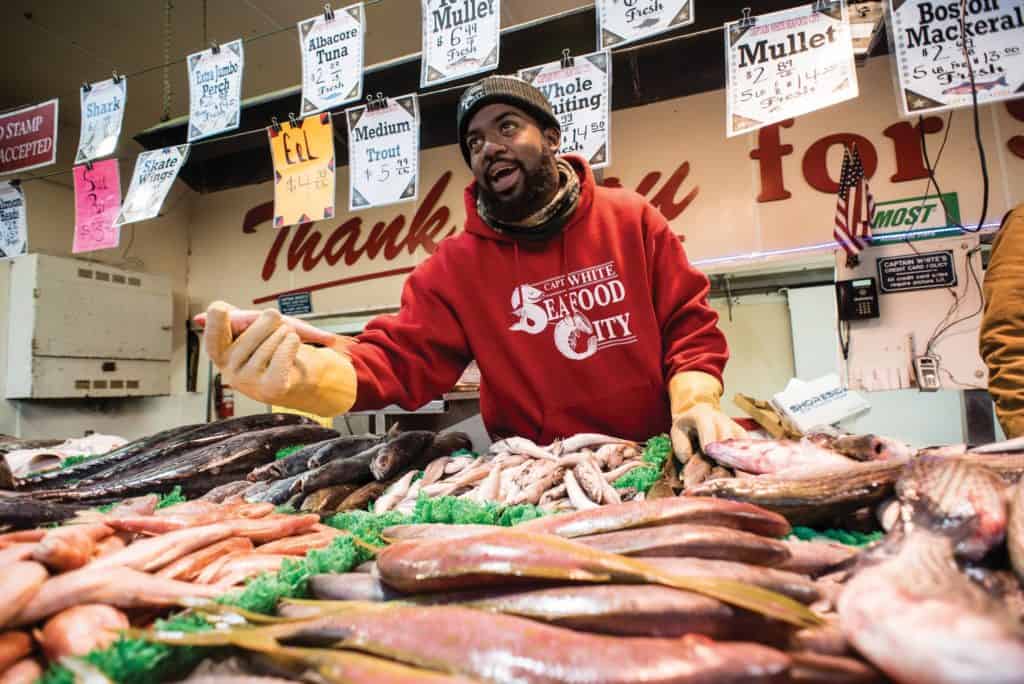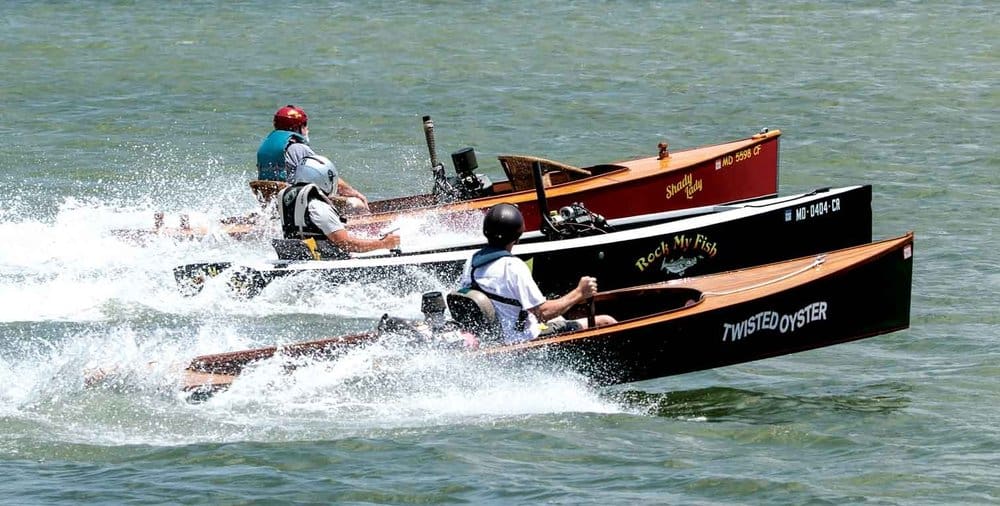The country’s oldest continuously-operated fish market stays afloat as the D.C. Wharf goes upscale.
On a chilly weekday along Washington D.C.’s southwest waterfront, a helmeted construction worker hurries along Wharf Street. He’s clutching two plastic bags bulging with takeout containers from one of the barges comprising the Maine Avenue Fish Market, a gritty D.C. institution wedged between the city’s stylish $2 billion redeveloped waterfront and a bridge abutment. Striding between two piers, the workman evokes the dockhands, schooner captains, fishmongers, oyster shuckers, herring cutters, and fish packers who’ve tramped along this path before.
It’s shortly after noon. A military helicopter thumps low over Washington Channel, heading toward the Tidal Basin. Lines are forming at the cook barges—aromatic carryout joints that fry, steam, broil, and grill fresh seafood supplied by one of the two families still operating businesses here.
Around the corner, flanking a plaza-like concrete pier, more barges topped with colorful awnings and eyeball-grabbing illuminated signs beckon customers. The market barges’ stainless steel trays, bedded in ice, display any seafood you can imagine: black bass, branzini, and butterfish; catfish, clams, and conch; porgies, pompano and perch; rockfish, rock shrimp, and red snapper; smelts, spot, and squid. There are shrimp as big as bluegills, salmon heads for soup-making, and piles of oysters: Chesapeakes next to Chincoteagues next to Blue Points. And, of course, blue crabs—loads of them—sorted by gender and size and goosed into summer sprightliness by the warmth of portable deck heaters.
Her head cloaked in a large scarf, Melina, a nanny whose employers live nearby, scrolls on her phone as she waits at Jessie’s Cooked Seafood barge for her lunch order: cream of crab soup and fried calamari. She discovered the Fish Market just yesterday. “It smelled so good,” she says, “I came back today.”
While she waits, the cashier rings up an order for two District of Columbia police officers: a whiting sandwich for Officer Steve Evan; red snapper for his partner, Officer Nicole Allen. Tossing in utensils and napkins, the cashier secures the bagged meals with a quick twist and hands them up to the officers, who must bend slightly to retrieve them. When the tide is low, or nearly so, the barges float well beneath their sidewalk clientele.
Like many D.C. natives, Officer Evan is no stranger to the Fish Market, “I’ve been coming here all my life. It’s famous.” Allen, who’s from the South, says she prefers her snapper with grits, but the boat doesn’t serve them. So, like Evan, she’s accompanying her meal with another deeply Southern side dish—hush puppies. Nearly the size of tennis balls, the warm, crunchy-crusted, fluffy-centered orbs are the essence of comforting street food on a winter’s day.
D.C.’s finest will find a warmer place to eat. Other diners make do. Two convention-goers from Texas claim a spot at a narrow standup counter to enjoy crab cakes and gumbo. Despite the celebrity chef-run restaurants and trendy bars that line the new Wharf Street esplanade, they’ve chosen the Fish Market for their first D.C. meal. It got raves on Yelp, the woman explains.
Washington’s premier fish emporium—the nation’s oldest continuously operating open-air fish market, by repute—has lured devoted customers for centuries. Presidents, congressmen, Supreme Court justices, millionaires, and movie stars have shopped and snacked here. So have not-so-famous-nor-particularly-wealthy locals. And it’s a favorite lunch destination for federal employees who work in the modernist government buildings that loom between the waterfront and the National Mall.
In Pierre L’Enfant’s geographically quartered Washington, Southwest has always been the runt quadrant. It’s the smallest in size, often marginalized socially, and historically isolated by now-extinct waterways or modern freeways. Through the years, its greatest asset—the riverfront—promised more than it could deliver as major port or recreational attraction. Which meant that, at regular intervals, some well-meaning or revenue-hungry entity would decide Southwest needed to be “fixed”, and so the neighborhood was redeveloped—mostly for the better, but sometimes not.
Through it all—poverty and prosperity, filth and sanitization, multicultural harmony and architectural invasion—Southwest’s fish sellers have stayed put at the watery end of 11th and 12th streets. It hasn’t been easy.
Consensus says the Fish Market began operating in 1805, but fishing boats were selling their catches along the Southwest waterfront as early as the 1790s. The first permanent market structure—replacing a ragtag, post-Civil War assortment of shacks—didn’t open until 1918. It lasted until city developers bulldozed and rebuilt Southwest four decades later. Eventually, Washington’s legendary fish vendors came full circle, herded once more from buildings to boats forty-some years ago.
Washington’s golden era of fishmongering stretched from the end of the 19th century through the early 20th, surviving world war, economic recession, and jurisdictional bickering over federal land overseen by the District of Columbia.
In the 1800s, the wharf at 11th and Water streets was a lively place. Every spring, schooners emptied their packed holds of shad and herring there, fish purchased directly from the smaller boats and watermen who netted them on the Potomac River. Wholesalers bought herring for $6 to $7 per 1,000, and shad, fat with roe, for anywhere from $15 to $20 per 100, according to newspapers of the day. “Cutters” earned a good living cleaning fish right on the wharf. The buyboats unloaded another moneymaker, Chesapeake Bay oysters—332,000 bushels in 1886.
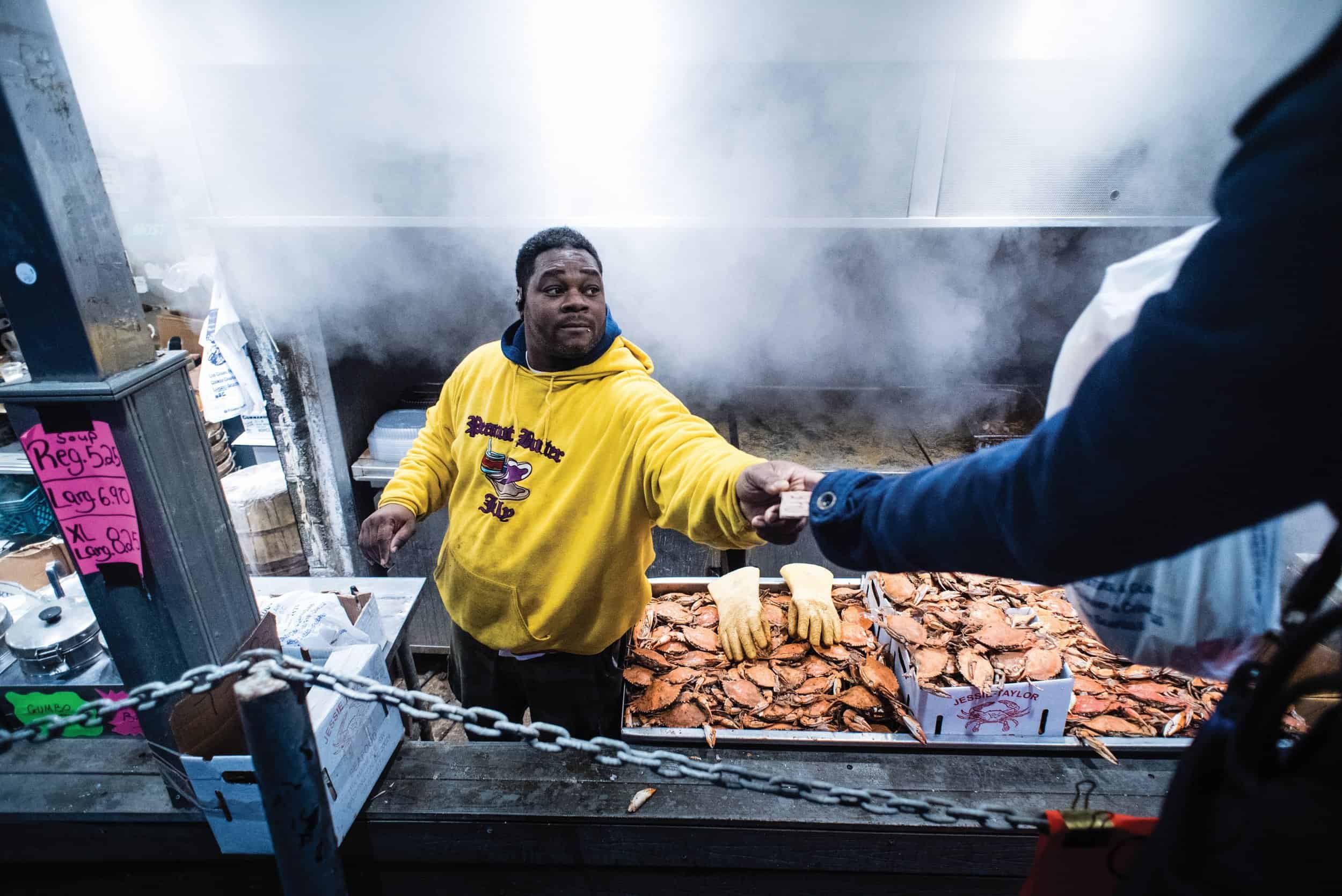
A percentage of these proceeds lined the pockets of the Riley family that ran the wharf and paid the District a modest sum for the privilege of levying wharfage fees. The city’s annual rights auction became such a farce with old man Riley always the lone bidder that the Washington Post ritually covered the charade. The auctioneer opened with the city’s minimum bid, $200, and then waited, and waited, and waited, for another. Only then would Thomas Riley, ensconced in his buggy nearby, make his offer.
“Mr. Riley demurely emerges from his retreat with his customary bid, which is never more than he has to give, and which is generally accepted,” the Post reported in 1903. Once, he bid $100, “and not one cent more,” the paper quoted him, before he relented. Another year, he failed to show up entirely and had to be summoned by telephone.
The city finally tired of Riley’s dithering and, spurred by the family’s refusal to repair the rotting wharf, tried to terminate the arrangement in 1908 and run the wharf itself. Riley sued. Five years passed before the city took control and officially designated the wharf the landing site for all seafood arriving in the city.
By that time, there were three wharves at the site: one for winter oysters and summer watermelons, one for fish, and one for lumber. Steamboats came and went from the 7th Street wharf. Small shipyards dotted the waterfront. Fishmongers’ wooden shacks lined one full block of Water Street. Sanitation wasn’t among their priorities. Nor was maintenance. Fish were cleaned beside a fly-infested horse stable. Shack roofs leaked rainwater on seafood. The wharves were falling apart. The neighborhood reeked. A 1909 report by the city’s Wharf Commission called the waterfront “a disgrace to the city,” adding “insanitary conditions at the fish wharf are a menace to health demanding immediate remedy.”
Redress took nine years. After budget haggling with Congress and two years of construction, the city proudly opened its state-of-the-sanitation-art Municipal Fish Market in 1918. The brick, Colonial-revival building with its plantationesque colonnade stretched an entire block, housing 24 gleaming vendors’ stalls and administrators’ offices. Two smaller structures went up across Water Street: a lunchroom for market workers and an oyster-shucking shed.
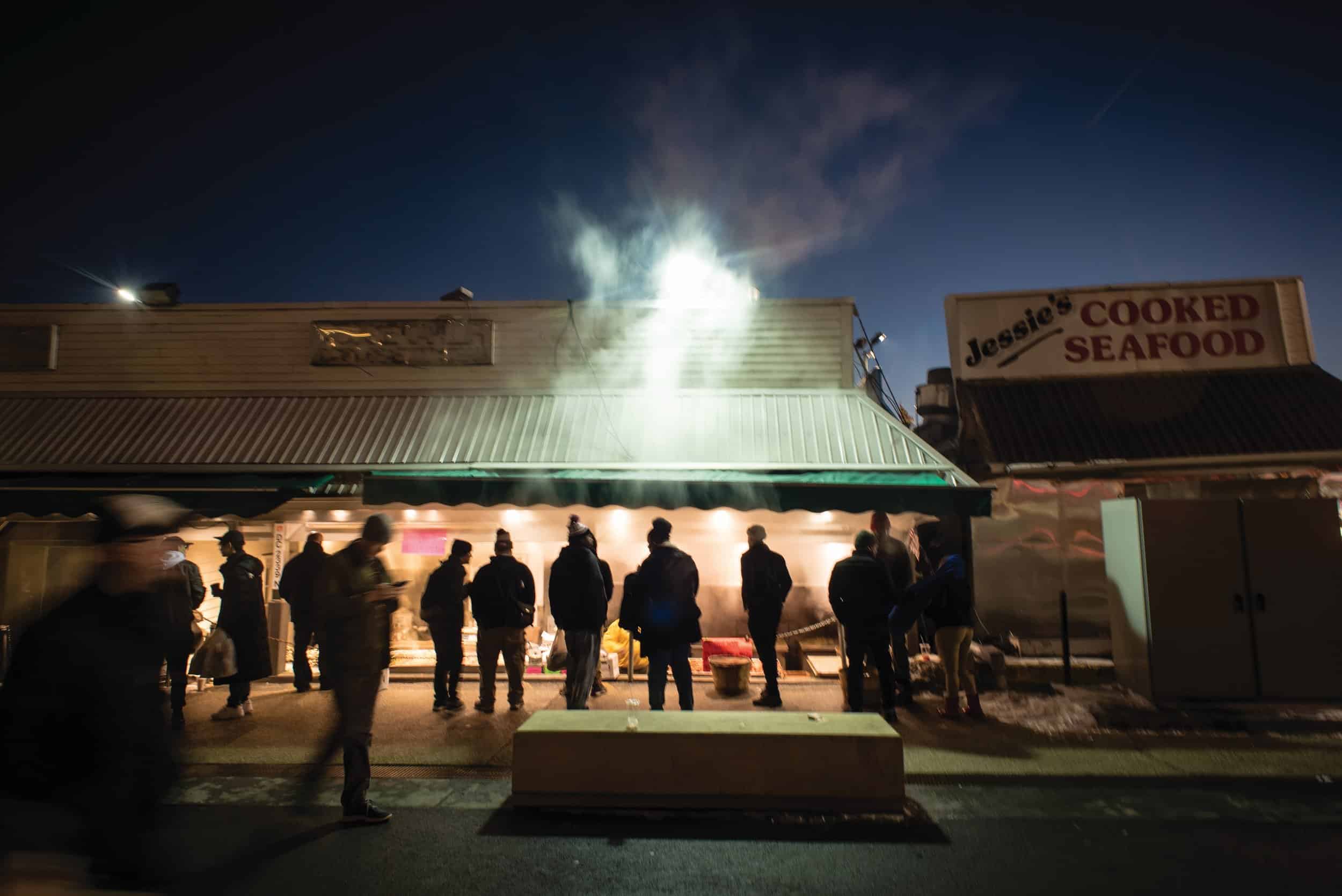
Market and wharf were booming in the 1920s and ’30s. In 1922, the market sold 7.7 million pounds of fish and, four years later, tallied more than $2 million in gross sales. Buyboats from Crisfield, Smith and Tangier islands, and other Bay communities jockeyed for position at the docks, where “vessels were piled nose to nose, and going ashore was merely a matter of being agile in hopping from prow to prow,” the Sunday Star noted in 1929. They arrived mid-week, sold their cargo by late Friday, and headed back for more. The hectic wharf, harbor police station, city morgue, a trolley car line, and numerous taverns disgorging a reliable supply of drunks made for a colorful, 24-hour waterfront.
During the Great Depression, customers scrimped by buying bluefish (15 cents per pound) or croaker, which was a nickel cheaper. Even World War II didn’t slow sales. Helped by meat rationing, the market sold 30 million pounds of seafood in 1944, worth nearly $7 million. By then, however, most of it arrived by truck.
Dramatic change came in the 1950s by way of the nation’s first experiment in urban renewal. Southwest got to be the Petri dish. By 1960, developers had purged it of scores of buildings and more than 23,000 residents to make way for high-rises, office buildings, and the Southwest Freeway, whose overpass abutment now marks the Fish Market’s upstream boundary.
“They essentially bulldozed a big swath of Southwest and started anew,” explains Carolyn Crouch, whose company, Washington Walks, leads a Southwest waterfront tour. “It was a complete flop,” she says of urban-renewed Southwest. “It did not become the jewel in the crown.”
The 1918 Fish Market building came down in 1960, replaced by dockside stalls. Echoing history, the fish dealers’ shacks were declared unsanitary in 1975, and fishmongers began selling from their boats—again. “It don’t make no sense to me,” one told the Washington Post, “[but] you can’t buck the health board.”
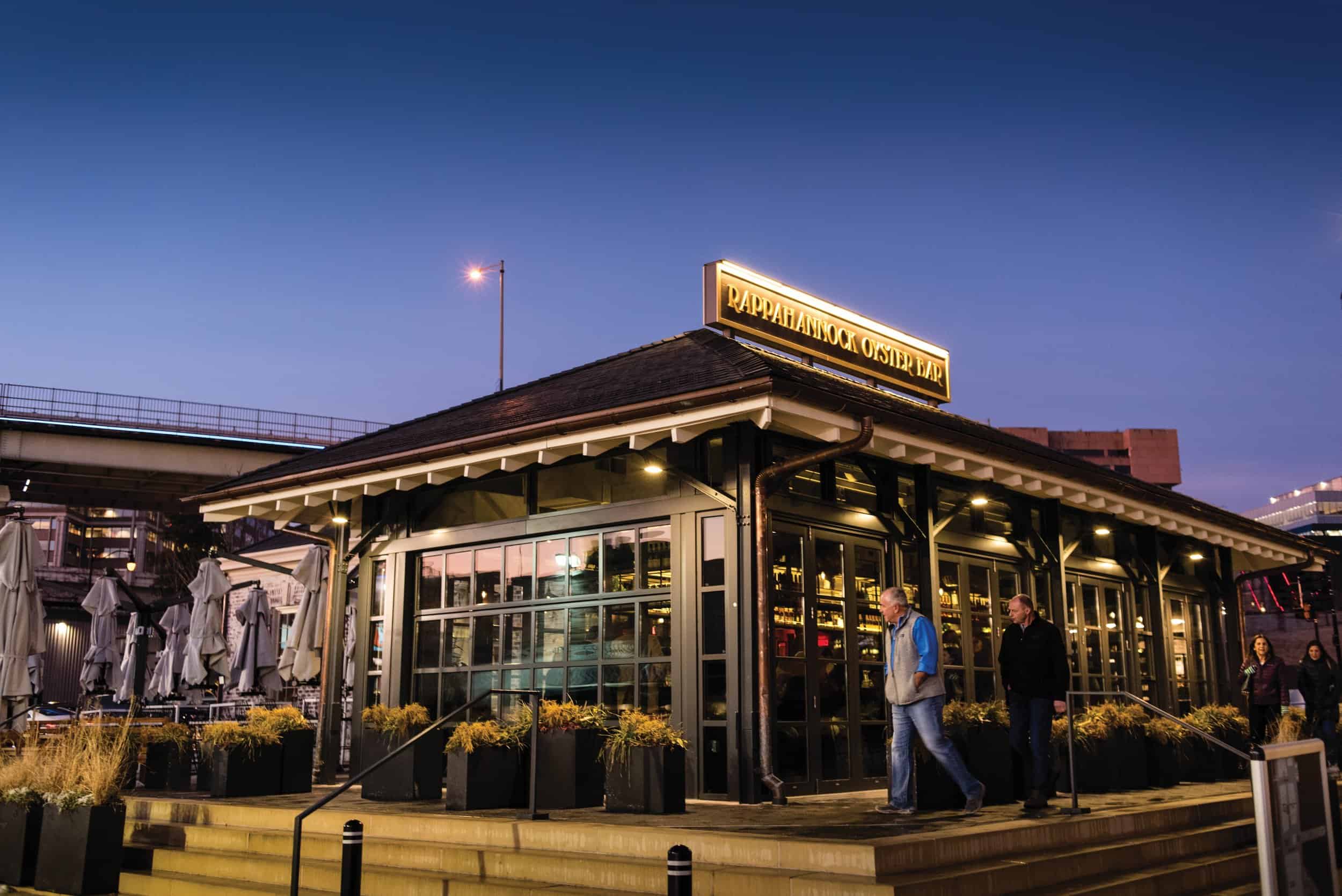
Sunny White remembers those days. In 1972, he, brother Billy, and their father, Bronzie “Captain Pete” White, began selling trucked-in crabs from a picnic table near the wharf. “We had a boat up here we lived on, a buyboat,” he says, speaking by phone from his floating office despite an attack of bronchitis. “We’d work a week, sometimes a month, before we went home again.” Home was Hallwood on Virginia’s Eastern Shore, about five miles from where Sunny grew up beside Cattail Creek.
The Whites seized opportunity in the brutal winter of 1977. “We got a lucky break,” Sunny says. “Chesapeake Bay froze over. You couldn’t get any seafood for a couple months.” Captain Pete knew a supplier in North Carolina and the Whites kept selling when others struggled. A year later, they bought a 60-foot wooden barge, built a little structure on it, added refrigerated storage, and claimed the last spot at the wharf. A steel barge has since replaced the wooden one, but Captain White’s—operated by the White brothers and their families—still sits prominently at the end of the pier.
The Evanses of Smith Island are the other, older, Fish Market dynasty. In 1939, founder Chelton Evans bought the buyboat Jessie Taylor, and, with his brother Filmore, began buying seafood from Bay watermen en route to Washington’s fish wharf. (A third brother, Stanley, later joined the business.) Like the Whites, they transitioned from buyboat to barge in the 1970s, although the families dispute whose came first.
Four Evans grandsons run Jessie Taylor Seafood today. Co-owner Greg Evans has worked here for 30 years, starting at age 15. “It’s my family,” he says, as employees shuffle around him, filling customer’s orders. “It’s all I’ve ever done.” They work a time-honored Fish Market shift: seven days on, seven days off, commuting from the Eastern Shore on workdays, which last 12 to 14 hours. Business was even more hectic 30 years ago, Evans says. “The place was jumpin’ then. Seafood was cheaper.”
The Evanses and Whites slowly expanded their empires, buying struggling competitors, giving both businesses more barges for cooked food, raw bar, and fish-cleaning operations. Tremayne Dunbar used to work at Virgo Fish House, the market’s fish-cleaning concessionaire. After it closed in 2017, he joined Captain White’s.
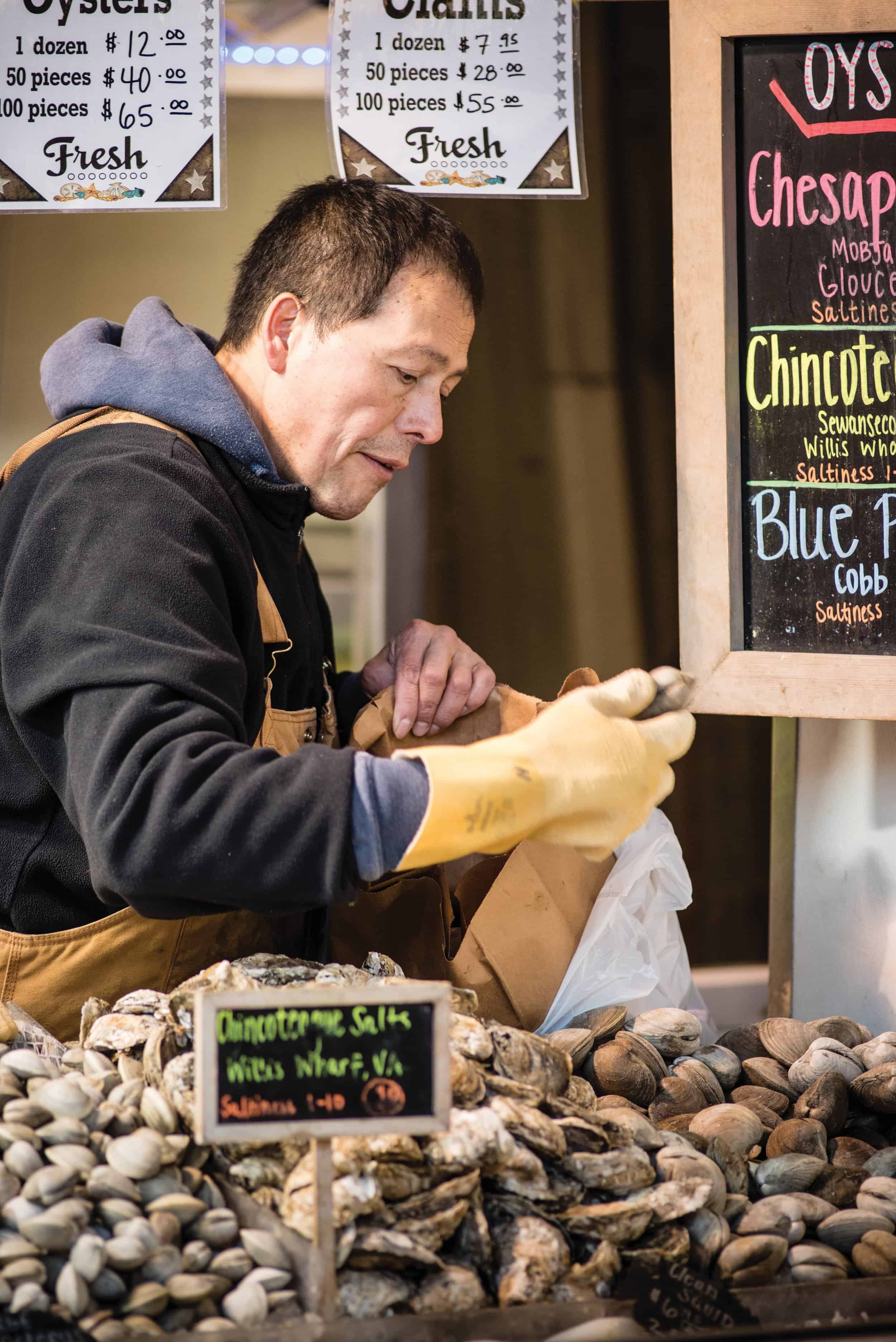
“To be honest with you, I was very happy,” Dunbar says of Virgo’s closing. “It was a different program; every fish cleaner there had to pay [rental] for a booth. With this gig you don’t have to worry about that.” Customers get a better deal, too, he says. They used to buy fish and then spend another $1 per pound to have it cleaned. Today, both fish-sellers offer free cleaning with purchases—tips appreciated, of course.
Dunbar is getting salmon-cleaning instructions from Grace Ochranek, who’s shopping at Captain White’s with her elderly mother. “I was going to carve out a piece for my sister,” she tells him of the enormous whole fish. “Oh, take the scales off. My sister and I will figure out the rest.”
Using an electric scaler, a dremel-like device that hangs from the ceiling, Dunbar starts on the fish, scattering scale bits like wood shavings. “You know what?” Ochranek adds. “My husband is going to want the head. Could you take it off and throw it in the bag?”
She’s a long-time customer. “My dad brought me here when I was about four years old,” she says. She lives in Yorktown now, but shops here once or twice a year. “The seafood is much better here. You can’t get octopus [in Yorktown], and I don’t necessarily think you can get as good an oyster—unless I’m not shopping in the right places.”
She leaves with $80 worth of seafood: the filleted, beheaded salmon, giant South Carolina shrimp that rival her favorite variety from the Canary Islands, a dozen raw oysters, and an octopus. At the base commissary where her husband shops, they pay $24 for two or three salmon filets, she says. Here, “I’m getting a whole fish for forty-five.”
If there’s one business that bridges the historic and modern fish markets, it’s Rappahannock Oyster Bar, the newest boutique raw bar/restaurant from Topping, Virginia aquaculturists Rappahannock Oyster Company. The handsome, glass-walled building occupies the extensively renovated, circa 1916 oyster-shuckers’ shed and dockhands’ lunchroom, mimicking their architecture. (Decades ago, lunchroom and shucking shed were joined to form a tearoom.) Manager John Paul Sabatier says the restaurant was literally built on oysters; during construction, workers unearthed piles and piles of old shells. Chef Autumn Cline tailors her menu to the site’s legacy, featuring the company’s own oysters and clams, crudos, seafood towers, and, an oyster house classic, fried-fish baskets. (Hers come with Asian dipping sauces.) “If I can’t source seafood locally, then I try to source sustainably,” she says of the menu.
Restaurant and market are part of The Wharf redevelopment. Despite initial public nervousness, developer Hoffman-Madison Waterfront, the Fish Market’s new landlord, has honored a pledge to keep the market and its essential scruffiness.
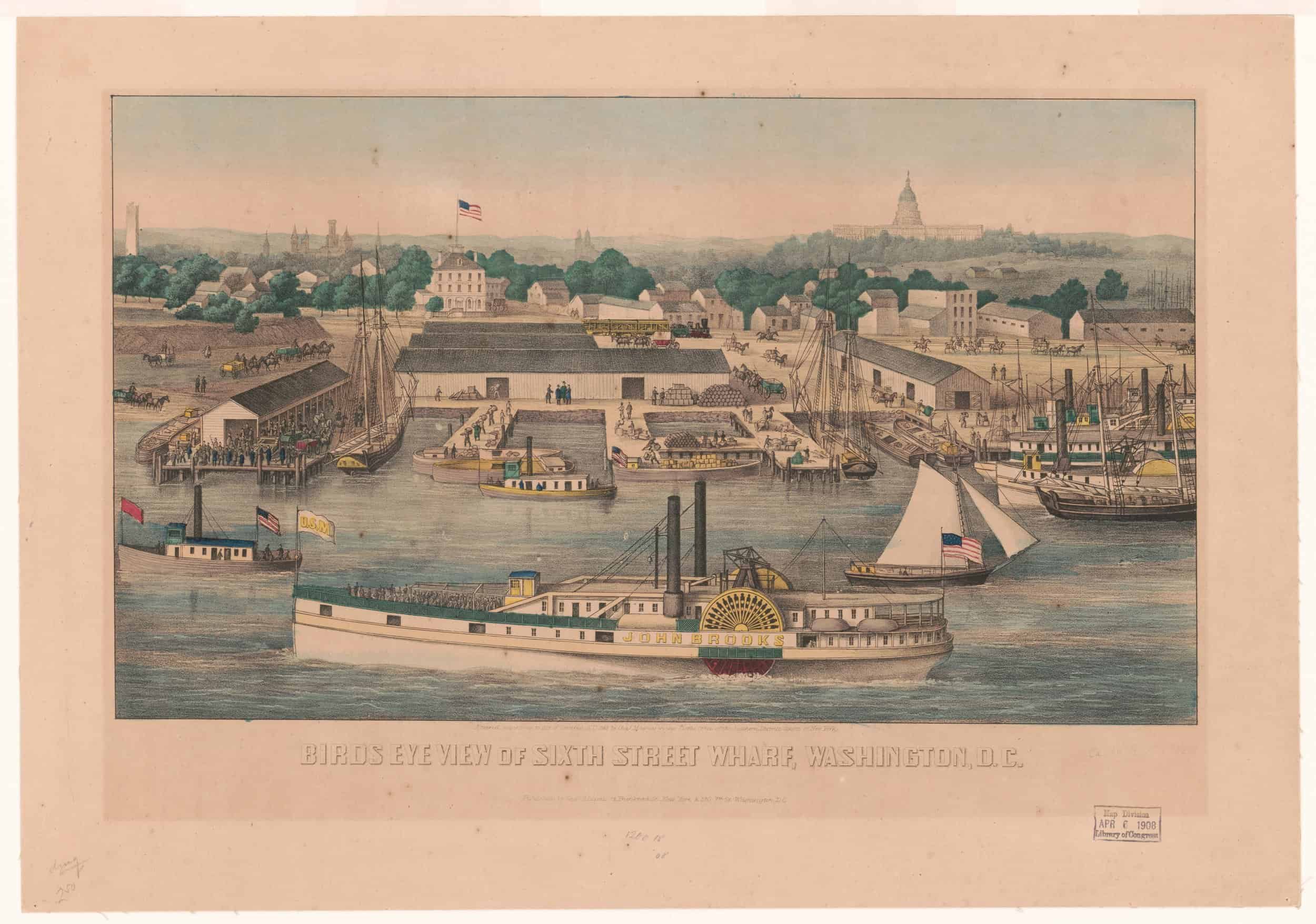 Wikimedia Commons
Wikimedia Commons
“We were able to preserve the area, add some infrastructure improvements, while keeping that authenticity. There’s something amazing and wonderful about these barges,” says Bob Rubenkonig, executive director of the association that manages the Wharf’s outdoor spaces. He remembers visiting the barges with his grandfather to buy crabs. Rubenkonig says the vendors have long-term leases, but he won’t discuss details.
The fish sellers, who’ve fought to preserve ostensibly long-term arrangements in the past, are philosophical about the future. Sunny White isn’t pleased developers relocated customer parking. “We’ll survive it,” he says. “You just got to accept it.”
Dunbar, the fish cleaner, worries about the trend in working waterfront revitalization, citing Baltimore’s Inner Harbor. “They pushed the [fish] market away from the waterfront.” Unless and until that happens here, he’s pleased to be scaling salmon and filleting big fish a while longer. “You just got to be prepared for the changes that are going to come,” he says.

